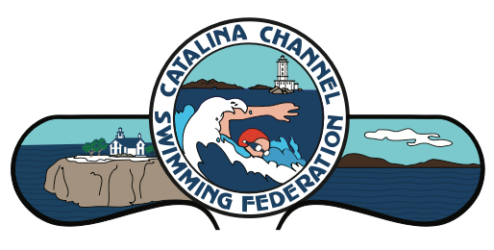FEEDING THE MARATHON SWIMMER
Weather conditions during the summer months in the Catalina Channel allow for kayak and paddleboard support. Yet every open water swimmer, in the case of unusual weather or a kayaker’s illness, ought to be prepared to feed from the escort vessel. This page focuses on feeding from the boat, its advantages and disadvantages.
Which endurance fuel to use is an individual choice. The expectation is that any serious marathon swimmer, before arriving to Catalina, will have experimented with several brands before choosing their favorites. Most swimmers bring on board their primary fuel, as well a couple of back-up options.
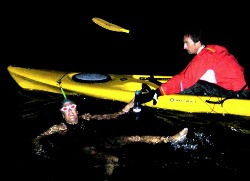 Cold water marathon swimmers are encouraged to feed quickly. The fastest open water swimmers will spend only a few seconds per hour in their feeding routine (less than 60 seconds per 60 minutes of swimming). Feeding from a kayak is the fastest method, which takes minimal effort on the part of the swimmer. Yet, this takes hours of training between swimmer and kayaker. A quick and effortless feed is a skill.
Cold water marathon swimmers are encouraged to feed quickly. The fastest open water swimmers will spend only a few seconds per hour in their feeding routine (less than 60 seconds per 60 minutes of swimming). Feeding from a kayak is the fastest method, which takes minimal effort on the part of the swimmer. Yet, this takes hours of training between swimmer and kayaker. A quick and effortless feed is a skill.
The alternative is to deliver feeds off the escort boat. It’s easier for an inexperienced team with more options to the feeding program: Warm liquids, solid foods, sudden requests for medications, or new swimming gear.
However, a word of caution, this feeding from the boat routine tends to be significantly slower. It can be especially difficult at night for the swimmer to locate fuel bottles. Plus, the swimmer must alter their path several times an hour. Feeding from the boat requires the swimmer to approach the hull. To many people this feels like an unnatural act. It takes courage. A novice marathon swimmer rarely gets the opportunity to swim along a large escort vessel and practice feeding.
NECESSARY EQUIPMENT FOR MANY FEEDING STYLES FROM THE ESCORT VESSEL:
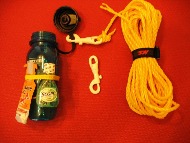
- Wide-mouth Nalgene, or screw top plastic bottles, or sports squirt bottlesfeeding gear from boat
- 50-feet of rope that floats on water (20-feet of line is sufficient if feeding from a kayak)
- Clips to attach rope to any of the feed bottles. Even two or more bottles at once
- Many swimmers use duct tape to secure bottles to ropes
- Strong and wide rubber bands around the feed bottle
- Glow sticks to attach to ropes & baskets
The easiest way to feed — for the support team — is one of the slowest and possibly hardest methods for the swimmer. Attach sports bottles to a rope and toss them into the water just a few feet in front of the swimmer. It’s then up to the swimmer to locate these bottles, which are slightly submerged. At night, this can be remarkably difficult. Even in daylight, with a wind chop or swell, swimmers can struggle to find their feed bottles.
You can make this process easier by always tossing the rope directly across the path of the swimmer. They will naturally swim over the rope and can pull the bottles toward them. Alternatively, floats may be attached to the rope. Floats with flags and glow sticks can visually assist the swimmer.
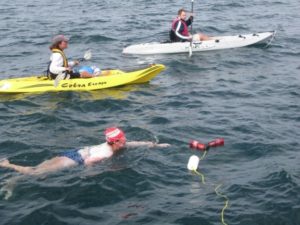 However, feeding from a squeeze sports bottle is the slowest and most difficult method. With the pop-top down, they’re tossed into the sea water. The swimmer must pop it open, grip & squeeze the bottle to force liquid out. It takes several squeezes to get a complete drink. This becomes more difficult as the swim prolongs. The swimmer’s hand strength and dexterity often fails in colder water, which will slow each feeding. Remember, speedy feeds help keep the swimmer’s forward momentum and delays the onset of hypothermia.
However, feeding from a squeeze sports bottle is the slowest and most difficult method. With the pop-top down, they’re tossed into the sea water. The swimmer must pop it open, grip & squeeze the bottle to force liquid out. It takes several squeezes to get a complete drink. This becomes more difficult as the swim prolongs. The swimmer’s hand strength and dexterity often fails in colder water, which will slow each feeding. Remember, speedy feeds help keep the swimmer’s forward momentum and delays the onset of hypothermia.
Instead of squeeze bottles, a wide-mouth plastic bottle can be tossed to the swimmer. This still requires them to unscrew the lid. But the wide bottle top allows the swimmer to chug it in large gulps. It’s the difference between sipping through a straw (sports squeeze bottle) and drinking from a glass.
An advanced method of feeding at the hull takes team work: The swimmer must feel comfortable swimming very close to the escort boat. The support team dangles an open bottle over the side-rail and down to the water level. In the darkness, it’s especially difficult for the support team to dangle the open bottle close enough to the water so the swimmer’s not reaching up. At the same time, it can’t be too close to the water. All it takes is one swell to dunk the open bottle into the ocean, and spoil the feed.
Illuminating the bottle at night will help the swimmer locate their feeding bottle. This could be a glow stick attached to the rope near the mouth of the bottle. Or a flashlight can be placed directly on the bottle to illuminate it. But a word of caution: A flashlight in the eyes of the swimmer is temporarily blinding. The flashlight should always be aimed at the bottle. As soon as the swimmer grabs it, turn off the flashlight.
It’s relatively simple to attach solid fuel and treats to a bottle with thick rubber bands. Gel packs can slide under the rubber band. You can deliver pre-opened packages of chocolate treats, bites of sandwiches, even gel caps of Ibuprofen. The rubber bands double as an “easy grip” for the bottles. As the swimmer fatigues, it becomes more difficult to handle big bottles. So it’s best to use the smallest and thinnest bottles for your feedings.
Feeding from the boat takes clear communications with your pilot. Not just the swimmer needs to feel comfortable, but the boat captain must have confidence the swimmer & support team are acting in a safe manner. It’s necessary to coordinate a few minutes before each feeding. This way the captain can place the boat in a position which will be easiest for the swimmer and support team to interact.
A word about water dynamics: The boat never fully stops during a feeding. The boat has much more momentum than the swimmer. It will continue to drift forward. So a feeding, which starts near the bow of the boat, may finish with the swimmer beyond the stern. The slower the feed, the further the drift. Therefore, it’s suggested to have at least 50-feet of rope attached to your bottles. If a swimmer drifts any further, it’s worth having a float at the opposite end of your rope. The support crew drops all the rope overboard. A kayaker will retrieve it, or the support boat could circle back around. Remember, to use a rope which floats so it can’t get caught up in the escort boat’s propeller.
What’s especially beneficial to the swimmer feeding from the boat is they’re always in direct communication with their support team. Plus, while the swimmer faces the boat during each feeding, an official observer is better able to gauge the swimmer’s fatigue and stress
A swimmer may ask for special treats and get them immediately delivered from the support boat. The variability is immense. A swimmer can request heated fuels, solid food, for new goggles, extra Vaseline, or an unplanned dose of medication. A swift-acting support team, prepared for these eventualities, can receive instructions from the swimmer and deliver the goods within the same feeding.
The downside is feeds from the boat will almost always take longer than those from a paddler. This increases the likelihood of hypothermia setting in. There’s additional effort on the swimmer’s part to get to the hull of the boat and then to locate the bottles. At night, swimmers are particularly cautious around the boat. It takes time before they gain comfort and confidence. There’s always the fear of being harmed by the boat. Unless the swimmer has made several Channel crossings, the support team is inexperienced with feeding from a support boat. Any swimmer can expect the first few feedings of a Channel swim to be “learning experiences” for them — and their supporters.
Most photographers put down their cameras in difficult swimming conditions. Therefore, you won’t find many pictures of swimmers feeding in the middle of the night. Nor in rough seas. But you’ll find plenty of beautiful swimming photos in idyllic conditions. Don’t let that fool you. It can get rough out there, but the swim goes on.
THOUGHTS ON HOW TO APPROACH FEEDING FROM THE BOAT
- If the swimmer is comfortable feeding on one fuel product at a time, rope feeding is a relatively simple method. Additionally, multiple bottles can be attached to one rope
- Construct all your feeding equipment from easily-found items at large nationwide stores. When traveling, you may have to construct your fueling gear from scratch only after you arrive
- Assume any supplies handed over the railing of the boat could get lost at sea — Kayakers must tiedown supplies and place gear into bags, which are strapped to the kayak. One capsize is all it takes for supplies to be lost at sea
- Therefore, arrive to the boat with plenty of back-up supplies of food, feeding equipment, bottles, and swimming gear such as caps & goggles. Pictured below, a sampling of the gear Dave Van Mouwerik packed for his successful crossing
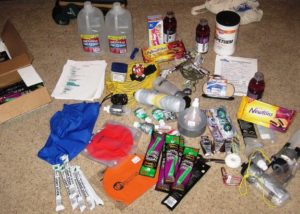
FORMS

